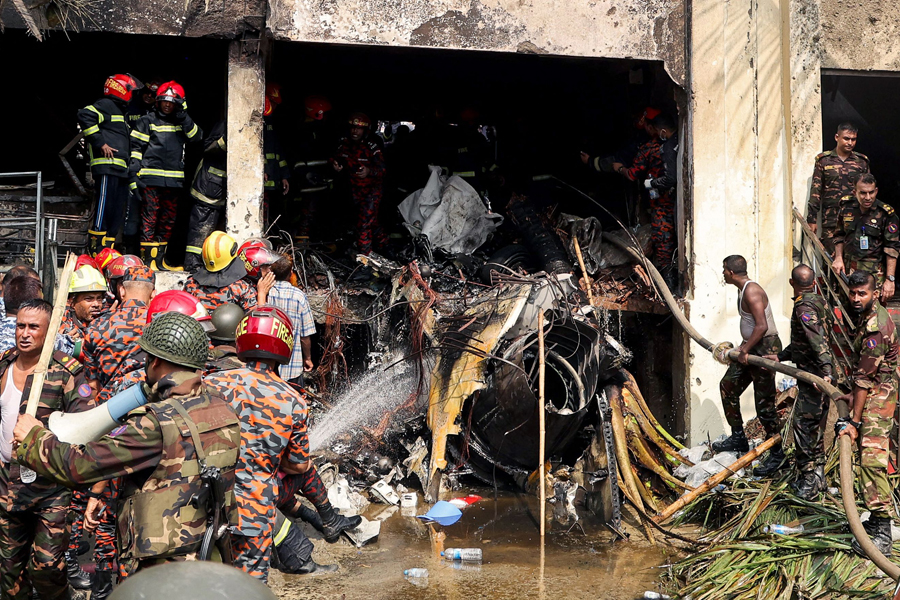
Published :
Updated :

Bangladesh is not at war, nor does it wish to engage in any conflict in the foreseeable future. However, with the drumbeat of war growing increasingly louder across the globe and several nations bearing the brunt of foreign aggression, Chief Adviser Muhammad Yunus, speaking at the Bangladesh Air Force's annual exercise programme last April, warned that not getting prepared for war would be suicidal.
Less than three months later, the country faced a war-like situation on Monday afternoon. The primary students of Milestone School and College in Uttara were preparing to leave the school for the day. They gathered in the school corridor. Just then, a fighter jet, out of nowhere and without any warning, rammed directly into the school building, engulfing it in a ball of flame.
In a split second, the school's joyous atmosphere, filled with laughter and chatter of innocent children, turned into a living inferno, a scene of unspeakable horror. At least 25 children were burned to death on the spot, 171 were injured and are now fighting for their lives in hospitals, and some guardians are still desperately searching for the whereabouts of their beloved ones.
The death of so many blooming children in a single incident is unprecedented in the country's history. The entire country is shocked and heartbroken as media sites are replete with agonising photos and video footage of the innocent victims' ordeal. The images of their lifeless bodies, the wails of bereaved parents and the scattered, blood-stained shoes, school bags, and ID cards of the little ones at the crash site evoke a chilling resemblance to tragedies in war-torn countries. One particularly shocking video shows a severely burned child, with his clothes and even hair completely burned off, limping down the street in desperation. These shocking and sickening scenes will haunt the collective memory of the nation for years to come. But more importantly, who is responsible for this grave tragedy? How to console the bereaved parents who have lost the apple of their eye?
Returning to the CA's comment on war preparation - yes, not getting prepared for war may be suicidal, but in a tragic twist of irony, the very act of preparation turned out to be suicidal. It wasn't a foreign fighter jet that struck the school, but one piloted by a trainee from our own Air Force. So, is this how we prepare for a war by killing our own children?
Accidents may occur due to human error, technical faults, or unavoidable circumstances at any moment. But some questions naturally pop up concerning the accident. Inter Services Public Relations (ISPR) said that the FT-7 BGI fighter aircraft of the Bangladesh Air Force (BAF) crash-landed due to a mechanical failure shortly after take-off from BAF Base in Kurmitola, and that the pilot had tried to steer the plane towards a less-populated area.
But the question is, why did the BAF choose to conduct fighter jet training over such a densely populated area, when it could have been carried out in remote char areas, in coastal regions? Conducting fighter jet training over densely populated Dhaka is tantamount to gross negligence and a clear violation of safety regulations, especially given that crash landings of BAF training aircraft and fighter jets are not uncommon. FT-7 BGI fighter jets have crashed multiple times in recent years. The previous incidents received little attention because they occurred in remote areas with minimal casualties. This time, it caused a massive tragedy in the heart of the capital.
Dhaka, as one of the world's most densely populated cities, is already prone to a host of dangers like fire, road accidents, building collapse and so on. Now, if dangers descend from the sky, where would the city dwellers go?
The tragedy appears more painful when it is realised that a forewarning had been given about the dangers of using the civilian runway of Hazrat Shahjalal International Airport (HSIA) for military training purposes. The FT-7 BGI fighter jet travels at speeds nearly three times faster than commercial aircraft. Allowing such jets to operate on a civilian runway is not only a serious breach of safety protocols but also an open invitation to disaster.
Speaking to journalists, civil aviation experts have claimed that they have repeatedly warned both the BAF and HSIA authorities about the risks. But the authorities trivialised the warning and adopted no precautionary measures. As one expert lamented in Bangladesh, no action is taken until lives are lost.
Adding to the problem is the unchecked urban sprawl and haphazard growth of high-rises around the airport. Milestone School and College's Uttara branch, for example, is located just three kilometers from the HSIA runway. There are regulations prohibiting the construction of establishments like schools, malls, or multi-storey buildings near airport approach paths. Yet, the area is dotted with high-rises where only one- or two-storey structures should exist, posing a serious threat to aviation safety.
Last but not least, the catastrophe exposed a deep fault line in the country's air defence capabilities. The Chinese-made FT-7 BGI model of fighter jet is based on 1960s-era technology and had already gone out of production in 2013. Aviation websites describe them as relatively non-automated and risky. While the BAF fleet also includes a few Soviet-era MiG-29s, these second and third-generation aircraft has become obsolete in today's world of advanced stealth and radar systems. Their effectiveness in maintaining air safety is highly questionable, and using them for training purposes poses a mortal danger to both pilots and civilians alike. Therefore, as the nation mourns, it is also time for taking a hard look at the loopholes in air defense system and disaster preparedness, and demand accountability from those responsible.


 For all latest news, follow The Financial Express Google News channel.
For all latest news, follow The Financial Express Google News channel.